Porcelain Insulator News
by Elton Gish
Reprinted from "Crown Jewels of the Wire", September 1999, page 6
There are a lot of reports and it is difficult to decide what to discuss. The
amazing world of porcelain continues to bring us something new. I'm saving the
best reports for one of the next issues once we get the particulars straight -
stay tuned. You classic collectors will not be disappointed!
Mike Guthrie (NIA #3297) reported finding a M-2254 at an antique flea market
about 30 miles from his home in Fresno. What makes this insulator unique is the LIMA, N.Y. marking on the skirt. The three known marked
M-2254's
were all marked on the crown and found in southern California along with a few
similar unmarked specimens. Another interesting feature of Mike's insulator is a
mark inside the bottom skirt similar to a Thomas blue jean seam. On closer
examination, it appears that the seam-like mark was made by the threading
mandrel when it was extracted from the skirt. The glaze is a pretty mottled
light speckled tan. Bill Rohde (NIA #1219) was excited about adding this one to
his collection. For those of you not familiar with the Lima marking, it was used
by the Lima Insulator Co. in Lima, NY. The company was secretly owned by Fred
Locke from 1904 until 1908. Actually Fred's wife, Mercie, was the official owner
of the company.
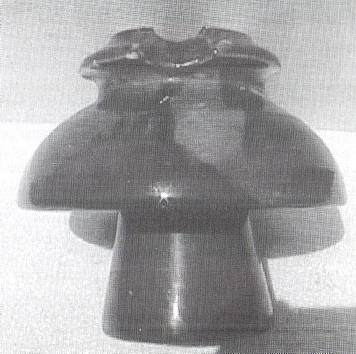
M-2254 (7 - 3.5 X 6.5) made by Lima Insulator Co 1904-1908.
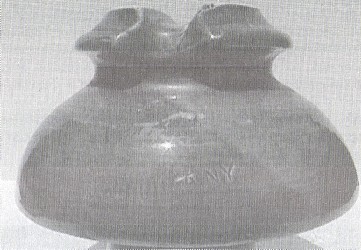
M-2254 with "LIMA, N.Y." marking on the skirt.
We've had some discussion in the past speculating that Fred Locke, on some of
his early insulator styles, made the crown separately and applied it to the top
skirt. This is especially the thought on multipart styles such as M-2795. We
know that Electrical Porcelain & Mfg. Co. made the under-glaze ink marked
specimens for Fred Locke and they produced U-927A in this manner. The cross-top
was made separately and hand applied to the body of the insulator. The badly
broken specimen of U-927A I cut in half clearly shows this feature. It is
obvious that the top skirts to the Fred Locke eaves-trough styles (M-2795,
M-2796, M-2335, M-2336, M-2336A, M-2785, M-2842) were not turned to cut the
tie-wire groove. Some Fred Locke multis even have mold lines over the dome that
show they were made in a two-part mold without the trimming operation to cut the tie-wire groove. So, how
did he make the crown on the eaves-trough styles without using a two-part mold?
Several people have speculated that the crown was made separately and applied to
the top skirt while the clay was still wet in much the same fashion as a handle
is attached to a teacup. Several clues to this are worth noting.
M-2336 (with #4-1 Fred Locke marking and manufacturing date, "APR 10
1901") is shown in the next photograph. Note the short, light aqua-colored
glass bottom skirt with an embossed "B" indicating that it was made by
the Brookfield Glass Co. Also note that the crown is missing as if it was
cleanly cut off. This insulator was found at the factory in Victor, NY a number
of years ago. It is interesting to note that an advertisement for Victor
Insulators, Inc. in the October 18, 1941 issue of Electrical World showed this
exact insulator. The four "Early Bird" insulators shown in one of the
pictures (left to right) in the advertisement are: M-2332, M-2336 (without the
crown), gray suspension disk, and damaged top to M-2785. If you look close at
the top of M-2336 (where the crown was removed), the surface is relatively
smooth with a hint of an inner ring. It is odd that the crown apparently was
removed so cleanly. I have heard of people knocking the crown off of a damaged M-2795 top with a sharp blow to the side of the crown. They report that the
crown, too, broke off cleanly.
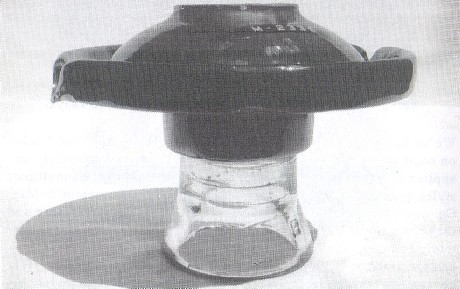
M-2336 with Fred Locke markings. Note the missing crown. This is the
same insulator pictured in the 1941 advertisement for Victor Insulators Inc.
Advertisement in the October 18, 1941 issue of Electrical World.
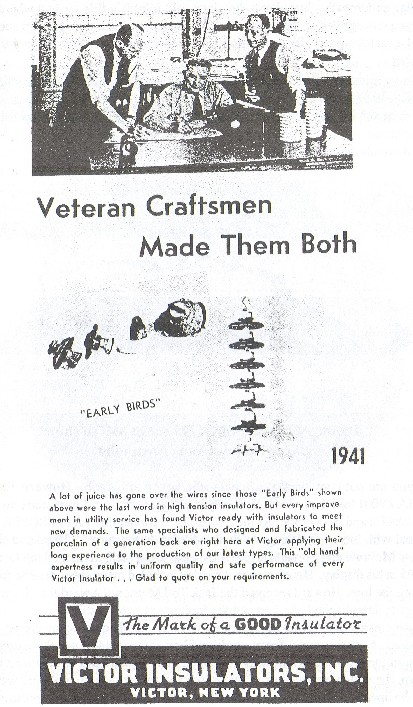
The next photograph shows the crown section of a M-2795 cut in half. You can
see a large air gap in the glazeweld joint between the top skirt and the collar
underneath. Just above the glazeweld joint is a thin air gap where the crown was
applied to the top skirt. There appears to be a raised center section and a
matching circular depression in the crown section where the two fit together.
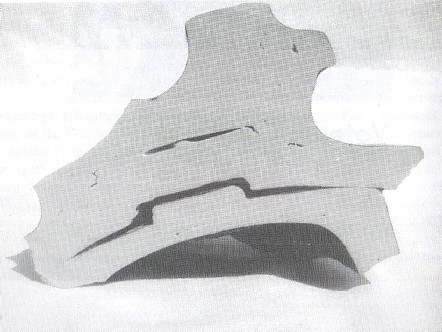
Damaged crown of M~2795 cut in half to
show glazeweld joint and crown joint.
If you are not convinced yet, look at the next photograph. Howard Banks (NIA
#900) found an old line in Oregon and has recovered numerous broken M-2842's and
M-2795's. At the Scottsdale National this year (a SUPER National with lots of
fun things to do in addition to the show - Thanks to show hosts Melanie and
Steve Marks!!!) Howard had a badly damaged top to a M-2795 in his display. His
educational display included many specimens he found along the line. Howard
received the Jack Tod Memorial Award for his fantastic porcelain display! As
you can see in the next two photographs, the crown broke cleanly and vertically
to expose the true details of how the crown was applied. Note the raised center
circle and how it fits inside a matching depression in the crown. Starting with
the crown and top skirt still in the moist clay form, the matching surfaces of
the crown and top skirt were probably wetted by the operator. The crown was then
fitted on the positioning circle protruding up from the top skirt. Next the operator probably took a wet sponge and ran
it around the joint to smooth the clay and help meld the two parts together.
After the clay was dried, it was dipped in glaze, dried again, and fired in the
kiln to complete the melding of the two parts. The joint would still be a weak
link and would explain why the crown is easily separated from the top skirt with
a sharp sideways blow. The crown on Howard's specimen is clearly mated weakly
and imperfectly to the top skirt with only the slimmest of fused contact. It
appears that only the outer part of the joint has any type of solid contact and
most of the strength of the crown attachment may be due to the glaze. It is
indeed a wonder that M-2795 performed so well on the northern California lines -
so well in fact that many were relocated to southern Oregon and Hawaii.
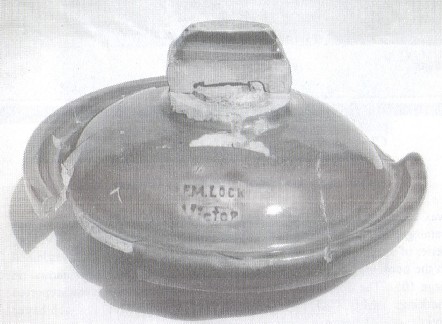
M-2795 top skirt found by Howard Banks.
Note the exposed crown detail.
It is noteworthy to point out two more things about Howard's M-2795 top
skirt. Note the "303" marking in the next photograph. The only known
whole specimen of M-2795 with the "303" marking is in the collection
of Tim Wood (NIA #1099). The photograph on page 98 in my book, Fred M. Locke: A
Biography, clearly shows (in the original photograph) one M-2795 top with the
"303" marking in the pile of 18,000 tops.
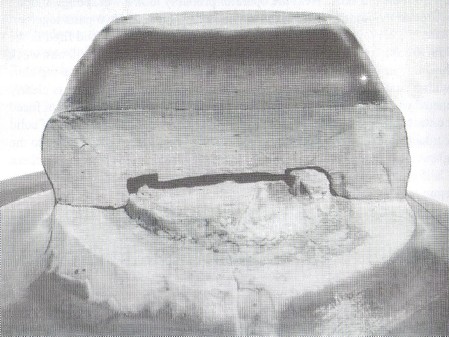
Close-up view of the M-2795 crown detail.
Note how the crown was made
separately
and poorly mated to the top skirt
The photograph was taken in June 1900 so we know the first production of M-2795 was
cataloged as No. 303. Later in the year Fred Locke developed the
"Victor" series of insulators and recataloged M-2795 as No. 316. All
this is explained in the book with the complete listing of the
"Victor" insulators shown on page 105. The opposite side of the
"303" marking has a new unreported marking: F.M.LOCKE / Victor. Note
the "V" in "Victor" is much larger and the other letters are
lower case. It is obvious that the markings used on M-2795 were changed when the
catalog number was changed from "303" to "316". The first marking used on the No. 316 was Fred Locke marking
#1-5. Therefore, we will
assign the following new markings:
Fred Locke marking 1-5a: 303/ PAT / DEC.15.96
Fred Locke marking 1-5b: F.M.LOCKE / Victor (note underlined letters larger than others)
Tim's M-2795 has marking #1-5 on one side and "303 / Victor" on the
opposite side. This could be a transition marking between the one Howard found and the ones known with Tim's marking but without the "303".
However, it is entirely possible that the placement of the "303" and
"F.M.LOCKE" was entirely arbitrary. That means there were four
distinct marking tools that had to be struck on every insulator! The complete
updated list of Fred Locke markings can be found in my book, Fred M. Locke: A
Biography.
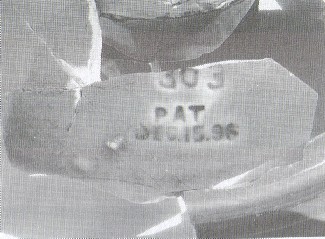
Howard Bank's M-2795 top showing "new"
Fred Locke marking #1-5a.
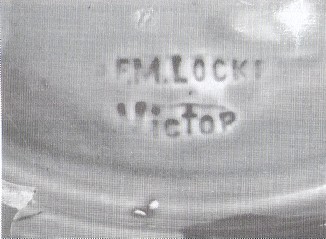
Howard Bank's M-2795 top showing "new"
Fred Locke marking #1-5b.
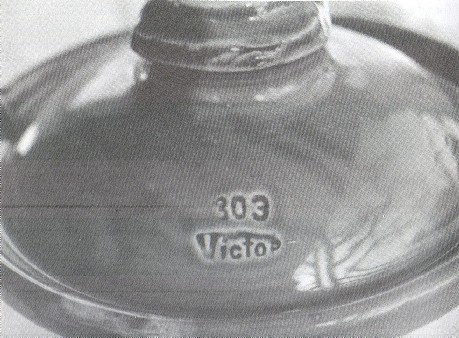
Tim Wood's M-2795 with rare "303" marking.
Note that the marking
was deeply struck.
This month's PIN is a bit longer than usual but we would be remiss if we
failed to mention two other Fred Locke specimens that fit in this topic of
applied crowns. Ken Willick (NIA #3709) dug a small crown at the Victor dump. The crown broke off cleanly with a smooth surface very much like what
is observed on the M-2336. Ken thought it might be from that same insulator.
When I got home with the crown, it was obvious that the crown was too small for
the M-2336. Note in the photograph that the small crown is an exact match for
the rare U-939C with manufacturing date: DEC 22 1900.
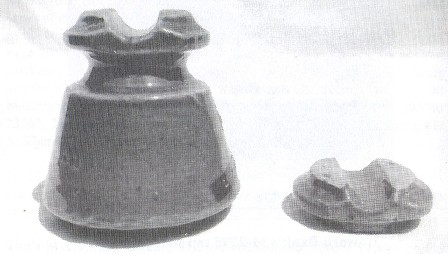
Fred Locke U-939C and small crown found at the Victor dump.
Mike Spadafora sent me a broken crown of M-2785 that he found a year or so
ago. Note in the photograph that it, too, has an applied crown. The small
section underneath is the collar glazewelded under the top skirt. The applied
crown extended down to at least the center of the tie-wire groove (the exact
joint cannot be determined). So, at least the top half of the tie-wire groove
was formed when the crown was applied. The extension of the crown down around
the raised section of the top skirt surely provided a more secure mating of the
two parts.

Broken crown of M-2785. Note the applied crown
included the top half of the
tie-wire groove.
| 